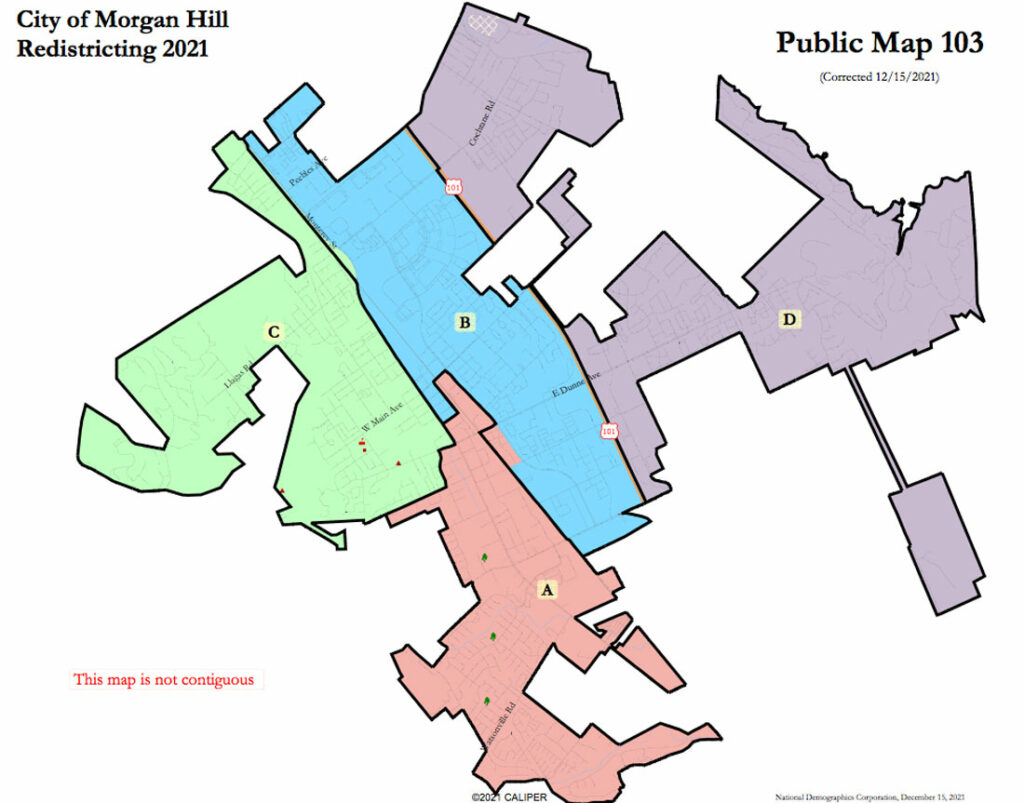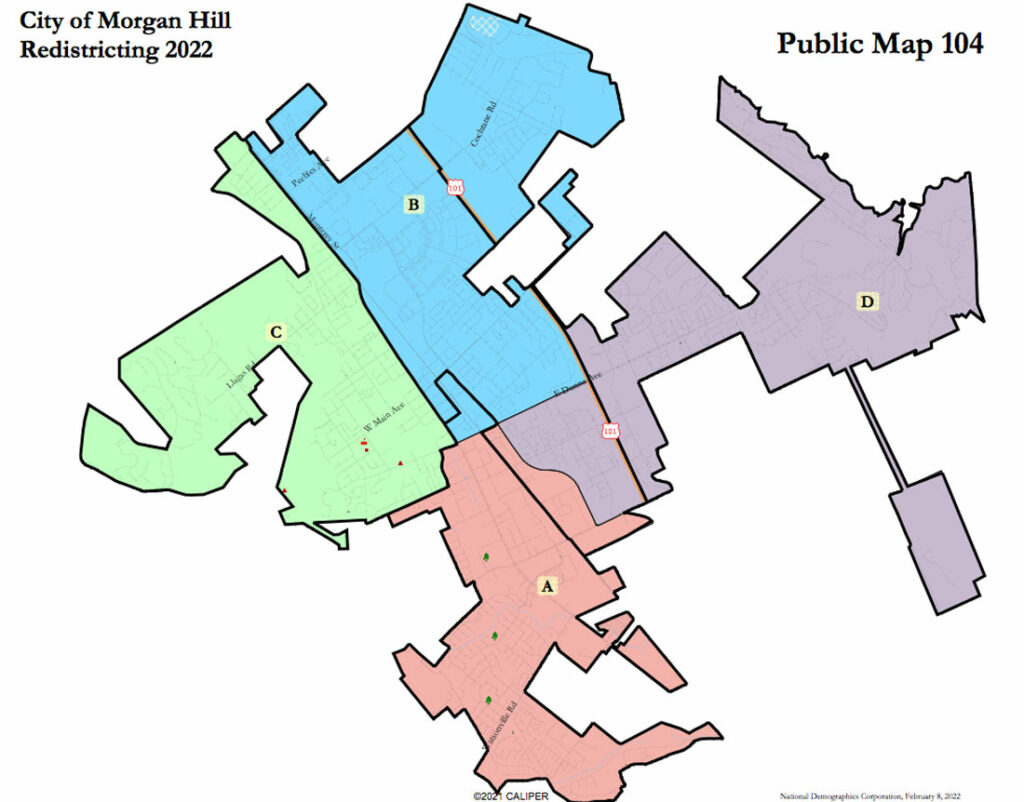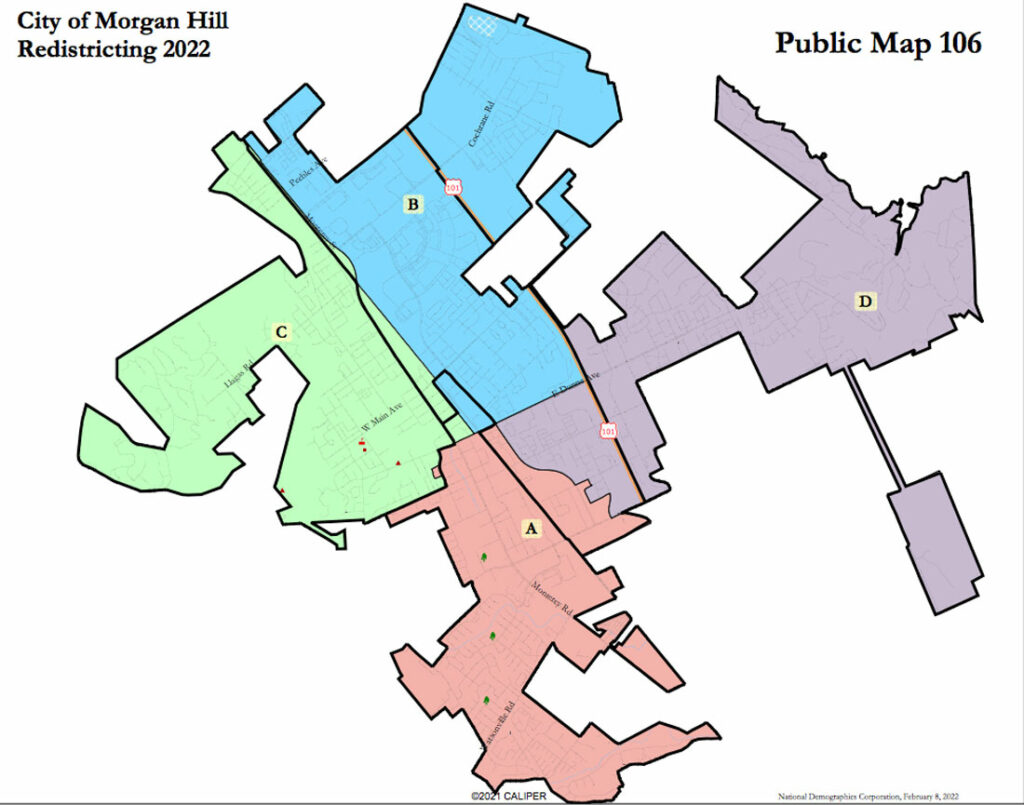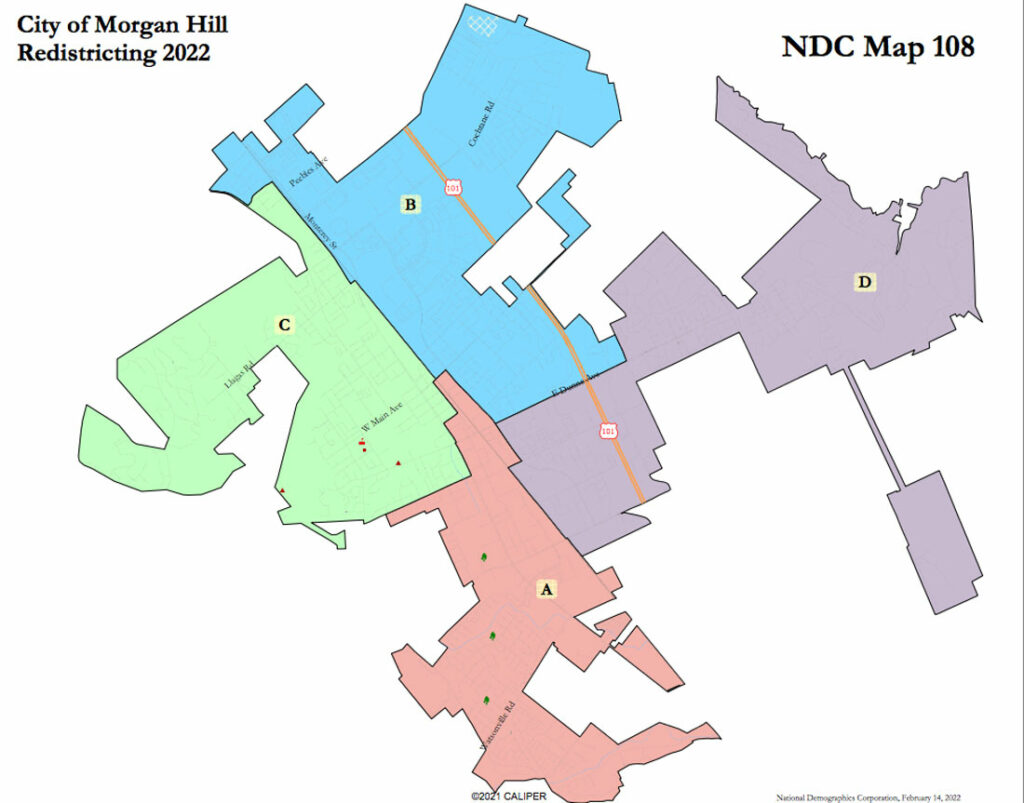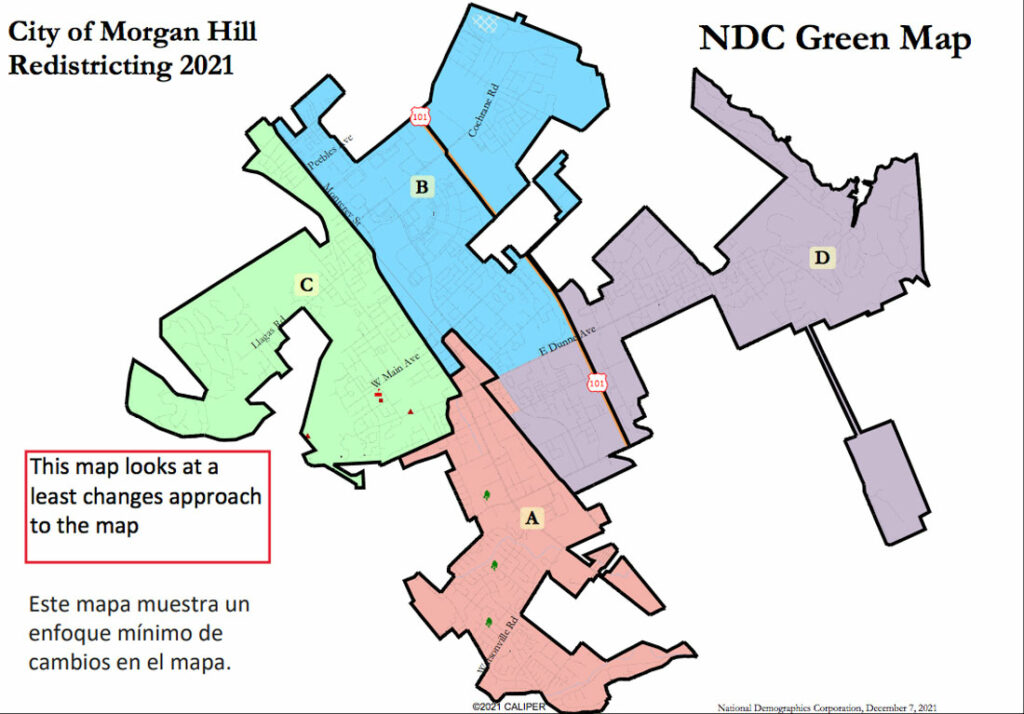
The Morgan Hill City Council has narrowed down its potential new district boundaries to a choice of five draft maps, but officials disagree on whether all of them would stand up to state laws regulating the electoral redistricting process.
In recent months, the council and city staff have held a number of public hearings and workshops on the redistricting process, which requires cities with elective council districts—among other government bodies—to review their boundaries every 10 years based on changes in population and demographics presented in the U.S. Census.
Throughout the process, voters in Morgan Hill have submitted map proposals using online tools—provided by the city and its consulting demographer—that make it easy for users to track and maintain population balances among the districts. The demographer, National Demographics Corporation, also created three draft maps for Morgan Hill’s four council districts.
At the latest council redistricting workshop on Feb. 16, a total of 11 draft maps created by the public and NDC were submitted for discussion. The council agreed to advance five of the draft maps to consider for approval.
The council will next discuss the maps and consider approving a single official district map at the March 2 meeting. The city has a deadline of April 17 to approve a map, which will determine the city’s council district boundaries for the next 10 years.
The Morgan Hill City Council wasn’t broken into districts until 2017, when attorneys threatened a California Voting Rights Act lawsuit in order to ensure the city’s minority population was adequately represented on the five-person dais. The subsequent balloting in 2018 led to the election of Yvonne Martinez Beltran, a Latina council member who represents the current District B.
Under the council district system, a single council member is elected from the voters within each district. The district elections are staggered two years apart, with Martinez Beltran and Councilmember John McKay, of District D, up for reelection in November 2022.
In Morgan Hill, the mayor’s seat remains elected at large, from among voters throughout the city.
One of the draft maps still under consideration for the coming decade may run afoul of state laws. “Map 103” keeps current council districts largely intact, but City Attorney Don Larkin said a state redistricting law passed after 2018 includes new requirements that render the existing boundaries illegal.
Namely, a provision in the new law, known as the California Fair Maps Act, requires that council districts be geographically contiguous. District D, which covers the east side of Morgan Hill, consists of two regions that are separated by a patch of unincorporated county land. Larkin has argued that this means the district is not contiguous, and thus Map 103 is illegal.
Other attorneys, including Morgan Hill resident Armando Benavides and Michael Baller—who led the 2017 effort to force Morgan Hill to adopt council districts—have disagreed in a back-and-forth debate over the state legislature’s intent in adopting the Fair Maps Act.
Larkin explained that prior to the FMA, cities could strike a balance in maintaining a list of priorities—including geographical contiguity—in new districts. The other priorities include keeping neighborhoods and “communities of interest” undivided; boundaries must be easily identifiable; and districts must be compact.
But now, under the FMA, being geographically contiguous is listed as the top priority, Larkin said.
“The way we have to do it now, they have to be contiguous such that they share a common border,” Larkin said. “And clearly, District D does not share a common border.”
Other draft maps advanced by the council Feb. 16 would separate the non-contiguous sections of District D into two new districts.
Benavides, who organized a number of members of the public to speak in favor of Map 103 at the Feb. 16 workshop, said he thinks the legislature’s chief intent remains to ensure equal voting rights for all groups of voters by preserving communities of interest. He said the law is written in a way that the council can declare that the districts are contiguous.
Benavides said Map 103 meets that intent. Specifically, Martinez Beltran’s prospective District B in Map 103 is “best overall to have a member of a minority group elected to bring diversity, equity and inclusion to the council,” Benavides said. “In 2018, that is exactly what happened with the election of Martinez Beltran to the council. So it is a performing district.”
But the definition of “communities of interest” is a moving target, according to city staff and elections experts. City officials said a typical community of interest would be an existing cohesive neighborhood, but it is up to the residents and voters to identify communities of interest to the council.
“Communities of interest are really challenging for folks because it’s really vague,” City Clerk Michelle Bigelow said. “People want us to tell them what a community of interest is, but (the law) is designed for voters to tell us what the communities of interest are.”
The council has not voted on any of the draft redistricting maps. Martinez Beltran at the Feb. 16 argued in favor of keeping Map 103 on the table. She said the communities of interest in Map 103’s District B (where she lives) include the city’s downtown, the region between Monterey Road and Highway 101, concentrations of high-density housing and a high concentration of residential renters.
Other requirements in state and federal law in creating council districts include they must be equal in population and may not promote racial gerrymandering, according to city staff.
Other members of the public cited their political preferences in wanting to keep the current map in place. But the state redistricting laws say that the preservation of an incumbent’s seat cannot be considered as a top priority in drawing new districts.
“(There) seems to be some underlying intent to break up the support of our only Latina councilmember, which would be discrimination,” Morgan Hill resident Sally Casas said at the Feb. 16 workshop. She was referring to Martinez Beltran.
Morgan Hill resident Doug Muirhead suggested each draft map should include a list of the communities of interest it aims to preserve.
“I would like the redistricting team to reach out to those who created the maps, and be specific in the communities of interest they are interested in,” Muirhead said.
McKay said he would have “no problem” staying in his current district. “But I want to follow the law,” he said at the workshop. “District B, with the third highest concentration of Hispanic voters, was the one that voted Latino (in 2018), so I don’t understand all the hubbub.”
The Morgan Hill City Council at the March 2 meeting will conduct another public hearing on the latest narrowed-down list of five draft redistricting maps. The hearing is scheduled to start at 8pm. For more information and to view the draft maps remaining under council consideration, visit the city’s website at morgan-hill.ca.gov/2179/Redistricting-2021.
The Morgan Hill City Council on Feb. 16 advanced the five draft maps below for consideration at the March 2 public hearing on redistricting:
